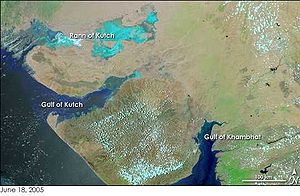This article may be in need of reorganization to comply with Wikipedia's layout guidelines. (August 2021) |

 |
| History of science and technology in the Indian subcontinent |
|---|
| By subject |
Indian maritime history begins during the 3rd millennium BCE when inhabitants of the Indus Valley initiated maritime trading contact with Mesopotamia.[1] India's long coastline which occurred due to the protrusion of India's Deccan Plteau helped it to make new trade relations with the Europeans, especially the Greeks, and the length of its coastline on the Indian Ocean is partly a reason why it's known as that since 1515, and was known as the Eastern Ocean earlier. The ocean was called so, due to the advent of international trade by the Europeans which still continues to this day. As per Vedic records, Indian traders and merchants traded with the far east and Arabia. During the Maurya Empire (3rd century BCE), there was a definite "naval department" to supervise the ships and trade.[citation needed] At the end of 1st century BCE Indian products reached the Romans during the rule of Augustus, and the Roman historian Strabo mentions an increase in Roman trade with India following the Roman annexation of Egypt.[2] As trade between India and the Greco-Roman world increased, spices became the main import from India to the Western world,[3] bypassing silk and other commodities.[4] Indians were present in Alexandria[5] while Christian and Jewish settlers from Rome continued to live in India long after the fall of the Roman Empire,[6] which resulted in Rome's loss of the Red Sea ports,[7] previously used to secure trade with India by the Greco-Roman world since the Ptolemaic dynasty.[8] The Indian commercial connection with Southeast Asia proved vital to the merchants of Arabia and Persia during the 7th–8th century.[9] A study published in 2013 found that some 11 percent of Australian Aboriginal DNA is of Indian origin and suggests these immigrants arrived about 4,000 years ago, possibly at the same time dingoes first arrived in Australia.[10][11]
On orders of Manuel I of Portugal, four vessels under the command of navigator Vasco da Gama rounded the Cape of Good Hope, continuing to the eastern coast of Africa to Malindi to sail across the Indian Ocean to Calicut.[12] The wealth of the Indies was now open for the Europeans to explore.[12] The Portuguese Empire was the first European empire to grow from spice trade.[12]
- ^ Cite error: The named reference
g&s12was invoked but never defined (see the help page). - ^ Young, 20
- ^ Ball, 131
- ^ Ball, 137
- ^ Cite error: The named reference
Lach2was invoked but never defined (see the help page). - ^ Cite error: The named reference
Curtin1was invoked but never defined (see the help page). - ^ Cite error: The named reference
Holl1was invoked but never defined (see the help page). - ^ Cite error: The named reference
Lindsay1was invoked but never defined (see the help page). - ^ Cite error: The named reference
Donkin1was invoked but never defined (see the help page). - ^ Yong, Ed (2013). "Aboriginal Australian genomes reveal Indian ancestry". Nature. doi:10.1038/nature.2013.12219. S2CID 87793562.
- ^ "Migration from India to Australia". Nature. 493 (7432): 274. 2013. doi:10.1038/493274c.
- ^ a b c Cite error: The named reference
Columbia1was invoked but never defined (see the help page).
© MMXXIII Rich X Search. We shall prevail. All rights reserved. Rich X Search
